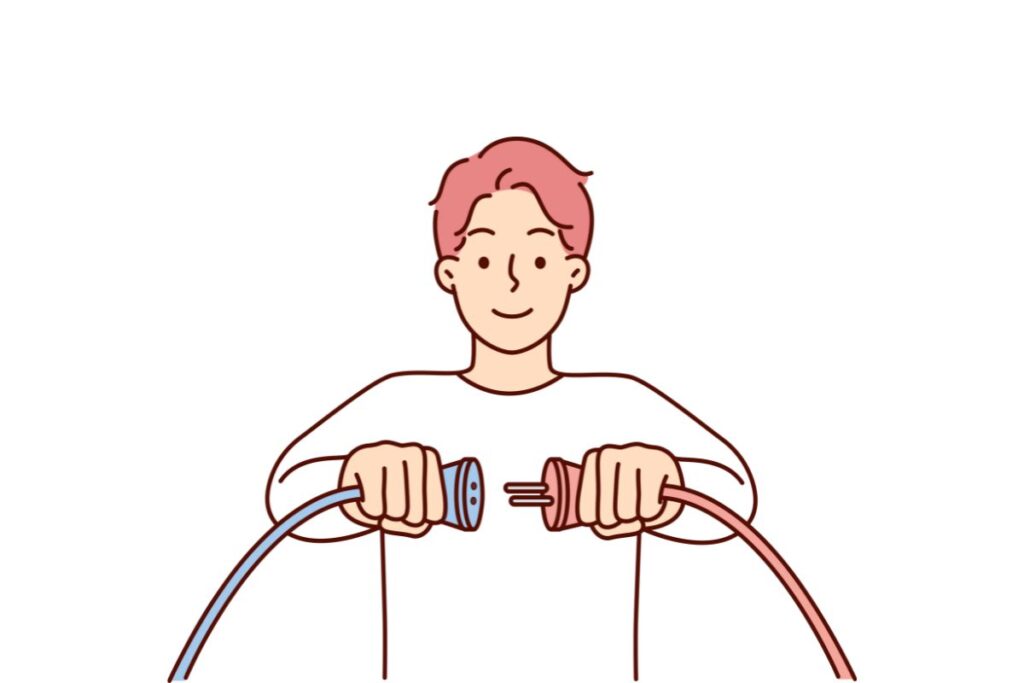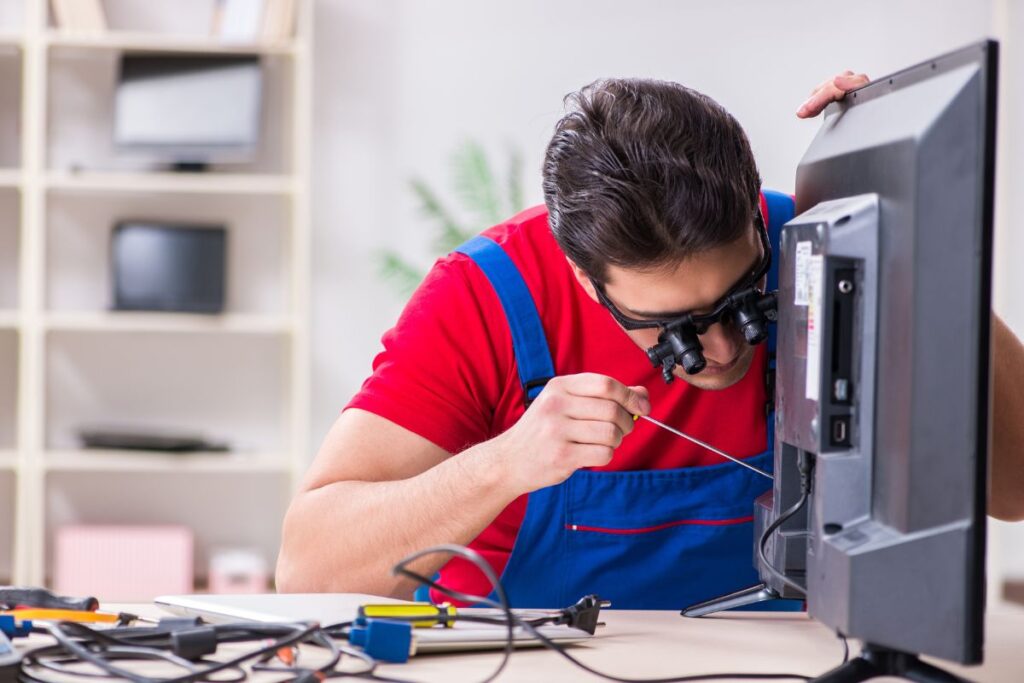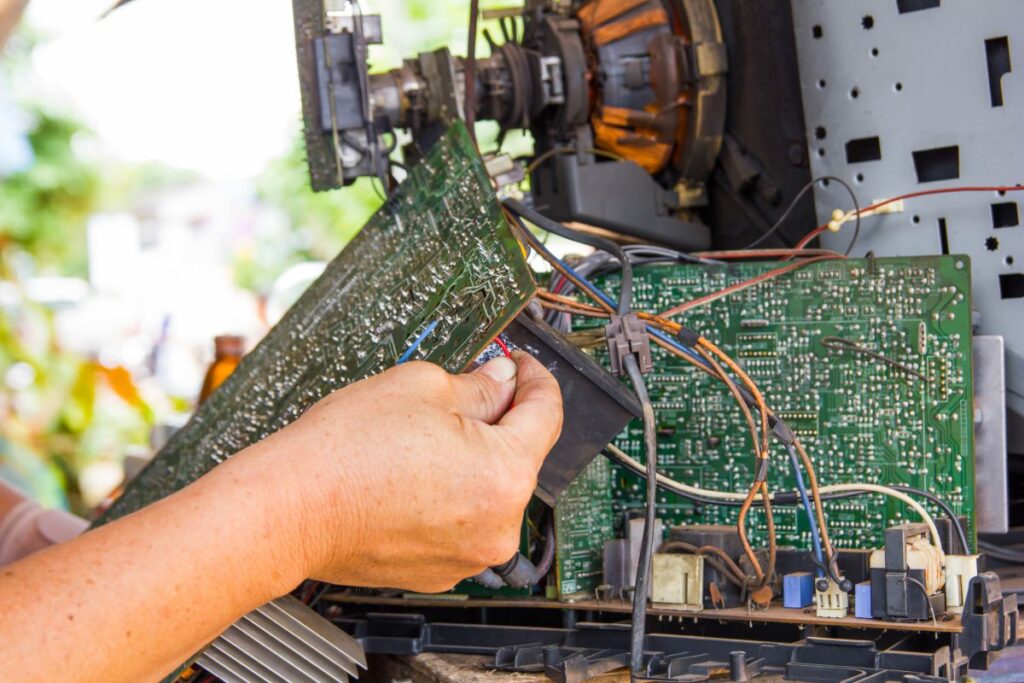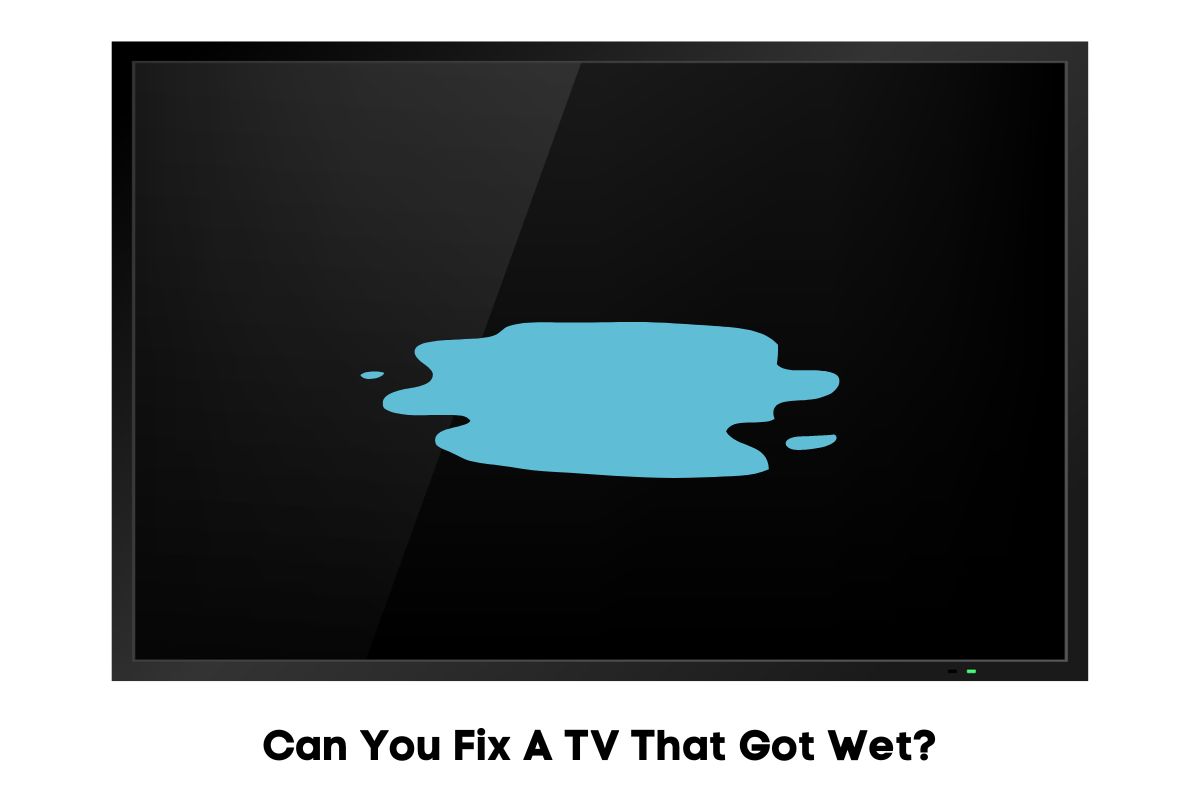You can fix most TVs. For substantial TV water damage, disconnect power promptly. Let the TV fully dry before consulting a professional technician. If damage is severe, a replacement might be needed. Prioritize expert inspection for repair or replacement guidance.
Safety Precautions When Dealing With A Wet TV
TVs are dangerous. This is true for any electronic device you introduce to water. If it wasn’t obvious, water is conductive. According to this guide from the School of Geography (Queen Mary University of London), the higher the concentration of dissolved chemicals, the more conductive the water.
This tells you that the water source matters. For instance, seawater is more conductive than bottled water because of the dissolved ions in seawater. This doesn’t mean you can pour bottled water into a TV without consequence. You have two concerns:
- Water is not a threat to circuit boards in an unplugged TV if you limit the duration of exposure. Problems arise when you forget to unplug the device. Water allows the current to flow between the board’s metal pathways, leading to corrosion and short circuits. You will wreck the circuit board.
- If the water is only a threat to circuit boards when the TV has a power source, pulling the plug from the wall outlet is enough to eliminate the risk, right? Wrong. Unplugged TVs are a threat to you because they have capacitors.
It can take the main filter capacitors several hours to discharge to a point where they can no longer deliver deadly shocks. This SCI Electronics Repair page wants technicians to discharge high-voltage capacitors fully before touching the circuitry.
Otherwise, a fully charged capacitor in a CRT monitor can deliver an average of 27,000 volts. This is enough to kill you.
Assessing The Extent Of Water Damage TO TV

Water does more damage the more time it spends inside your TV. Therefore, the sooner you find it, the sooner you can eliminate it. The following signs will show you that water has entered the TV:
- You will see water spots on the screen. They will persist even when you wipe the screen because the water sits between the glass sheets. You can’t reach it from the outside. Depending on the TV type, the water spots may resemble ink blotches.
- Lines will appear on the screen.
- The image quality will deteriorate. The screen may become blurry.
- The metal components will corrode. That includes the circuit boards.
- If you open the TV, you may notice discoloration and fuzzy growths, proving that the water has been sitting in the device for longer than you initially assumed.
- You may notice sparks in and around the electrical connections.
- The TV may refuse to start.
The extent of the damage will depend on the severity of the exposure. A small spill isn’t so bad if the water splashes the screen, but it avoids electrical conductors and power sources.
You can also make circuit boards wet without killing them if the TV is unplugged. You can’t say the same for a TV submerged underwater during a flood.
Disconnecting The Power

It is worth reiterating the fact that water conducts electricity. You can minimize water damage by disconnecting a wet TV from the circuit as soon as you notice the water:
- If the TV is on, use the remote to turn it off.
- Pull the plug from the socket. Touching a wet TV sounds dangerous. But the plug is harmless if it’s dry. However, you can cause arcing by pulling the plug out when the TV is on. Turning the device off via the remote is a safer option.
- What if the plug is wet? What if the entire room is splattered with water? Find the main breaker and cut the power to the whole house. This disconnects the TV without electrocuting you.
Drying The TV
When a TV gets wet, disconnect the power and take it to a repair shop. They can either fix or replace the damaged components. And if you need a new TV, they will let you know. But what if you don’t have access to a repair shop? Apply the following solutions:
- Unplug any peripheral devices still connected to the TV, such as consoles and DVD players.
- If the area is wet and humid, move the TV to a dry location and place it on a flat, stable surface.
- Wipe the exterior using a dry lint-free cloth.
- Remove the back panel and take a picture of everything you see. This will remind you where everything goes in case you forget.
- Find the circuit boards and take them out.
- Use a dry cloth to wipe the circuit boards. This is not enough to fix the problem. It will simply remove the excess water.
- Bury the circuit boards in bags of desiccant packets to absorb every ounce of moisture.
- Leave the circuit boards alone for 24 hours. Use that time to remove the excess water from the TV.
- If the TV was submerged in water, turn it upside down to pour the water out. You can also use a cloth to wipe every wet surface you see.
- Use a blow dryer. Keep it on a low setting. You don’t want to melt the plastic components. The blow dryer will remove the water from every nook and cranny you cannot reach with a cloth.
- You can also apply compressed air and vacuum cleaners.
- What about rice? People usually recommend it as an effective tool for drying electronics. Can you submerge a wet TV in a tub of rice? Yes, you can. However, USA Today argues that rice isn’t nearly as effective as people think. In fact, your electronics will dry faster if you leave them on a counter. Additionally, you don’t want to expose your TV to the dust and starch that rice introduces.
- If you’re desperate, place desiccant packets inside the TV. Instead of rice, put the packets in the affected areas to expedite the drying process.
- Don’t hesitate to turn the air conditioner or dehumidifier on where necessary. Create a warm and dry environment.
- Once the circuit boards are dry, retrieve them and apply isopropyl alcohol to combat corrosion. Be gentle. You don’t want to damage the boards.
- If you’re satisfied with the results, reassemble the TV and test it.
Professional TV Repair Services

Professionals are not cheap. A repair shop will charge you anywhere between $150 and $400 to fix water damage. The exact figure depends on the components they need to fix or replace. Nothing is off the table.
Your TV may require new bulbs, inverters, ports, and more. If you need a new screen, the repair costs may exceed the TV’s value. That doesn’t even account for the labor fees. Keep in mind that technicians charge an average of $120 per hour.
Nonetheless, a professional is the safest bet. Most laypeople are not tech-savvy enough to open a TV. Those who succeed are more likely to fall prey to deadly shocks by carelessly interacting with the capacitors.
If you survive, you may break the circuit boards while attempting to remove or dry them. Additionally, you won’t remember how to re-install the individual components correctly, especially if you forget to take pictures beforehand.
Suffice it to say, you will do more harm in the long run. As such, even though it is cheaper to dry a TV yourself, a professional technician is the safer option. If the labor fees worry you, consider as many repair shops as possible.
Don’t settle for the first expert you come across. Compare their prices until you locate a candidate with friendly rates. Some repair shops offer discounts to new customers.
Internal Component Inspection
Anyone can dismantle a TV. But that doesn’t mean they should. Most laypeople have two significant concerns:
- You may break the TV’s shell while prying it open, especially if it has hidden screws and clips. A manual can prevent this outcome. It will show you how to access and remove the back panel.
- The high-voltage capacitor has a lethal charge. CRTs are particularly worrying in this area because they use a lot of power. According to the experts at Instructables, it can take months for a CRT capacitor to discharge.
You can discharge the capacitor yourself. But merely attempting to interact with this component can lead to unforeseen accidents. You can fix a TV that broke because you pried it open poorly. You can’t fix yourself if the TV sends a lethal current through your body.
Leave the TV to an expert. They can inspect the internal parts to determine whether you should fix or replace them.
Circuit Board and Electrical Damage

Circuit boards are the most important components of a TV. A modern TV cannot operate without them. Unfortunately, circuit boards are also incredibly vulnerable to water damage. Water attracts the following consequences:
- This paper in Advances in Electrical Engineering, Electronics, and Energy has noted that moisture allows electricity to flow along unwanted paths. This affects a circuit board’s functionality by creating conductivity in places where it shouldn’t exist. The result is a short circuit.
- The salts and minerals in the water react with the circuit board, corroding the material.
The severity of the problem depends on the exposure. Don’t count out humidity. High humidity can combine with dust, creating a sludge that encourages overheating. A few splashes of water are not so bad. But small instances of corrosion can manifest later on if you do a poor job of drying the circuit board.
Submersion should worry you. The circuit board is more likely to suffer irreparable damage because of the contaminants in the water.
Warranty Coverage And Insurance Claims For Wet TV

- New TVs come with different types of warranties. A full warranty covers the entire TV. Limited warranties will get you specific replacement parts. You also have manufacturer warranties that cover material defects and unit failure.
- The period a warranty covers will vary depending on the brand.
- While the terms and conditions may change with the brand, most manufacturers agree that warranties should only cover factors they control. They won’t compensate you for damage that occurs because of ordinary wear and tear, natural disasters, or accidents. In other words, don’t expect them to fix your TV for free if it incurs water damage.
- If the water damage occurred during transit or before the TV was shipped, you must present the original receipt. You also need proof that the TV was damaged before it got to you.
- Insurance is different. They cover everything, including accidents such as water spills. But you should do your due diligence by reading the terms and conditions. Some insurers may expect you to specifically sign up for policies that cover water damage. Don’t assume that water damage is automatically covered until your insurer says so.
Prevention And Future Precautions To Protect TVs From Water Damage
Water damage is serious. If the water infiltrates the display panel, you may spend $1000 or more on a new screen. For that reason, experts encourage consumers to take steps that prevent water damage, including the following:
- Keep the TV in a clean and dry location away from water sources.
- Elevate the TV. Mount it on a wall to protect it from flooding.
- Keep the TV away from direct sunlight. Direct sunlight creates moisture.
- If you can’t avoid locations with nearby water sources, cover the TV with a waterproof case that repels moisture.
- Buy a waterproof TV.
- Install a humidifier in the TV room.
- Wipe the TV whenever you see condensation on its surface.

